Hoops Rumors is checking in on the 2025 offseason for all 30 NBA teams, recapping the summer’s free agent signings, trades, draft picks, departures, and more. We’ll take a look at each team’s offseason moves and consider what might still be coming before the regular season begins. Today, we’re focusing on the Utah Jazz.
Free agent signings
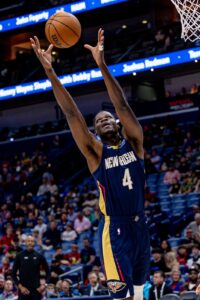 Mo Bamba: One year, minimum salary. Non-guaranteed (Exhibit 10). Signed using minimum salary exception.
Mo Bamba: One year, minimum salary. Non-guaranteed (Exhibit 10). Signed using minimum salary exception.- Steven Crowl: One year, minimum salary. Non-guaranteed (Exhibit 10). Signed using minimum salary exception.
- Matthew Murrell: One year, minimum salary. Non-guaranteed (Exhibit 10). Signed using minimum salary exception.
Trades
- Acquired the draft rights to Walter Clayton (No. 18 pick) from the Wizards in exchange for the draft rights to Will Riley (No. 21 pick), the No. 43 pick in the 2025 draft, either the Heat’s or Pacers’ 2031 second-round pick (whichever is most favorable), and the Jazz’s 2032 second-round pick.
- Acquired Jusuf Nurkic from the Hornets in exchange for Collin Sexton and either the Jazz’s or Clippers’ 2030 second-round pick (whichever is most favorable).
- Acquired Kyle Anderson (from Heat), Kevin Love (from Heat), the Clippers’ 2027 second-round pick (from Clippers), and cash ($2.5MM; from Clippers) in a three-team trade in exchange for John Collins (to Clippers).
- Acquired Georges Niang, either the Celtics’ or Magic’s 2027 second-round pick (whichever is most favorable) and either the Celtics’ or Cavaliers’ 2031 second-round pick (whichever is most favorable) from the Celtics in exchange for RJ Luis (two-way).
Draft picks
- 1-5: Ace Bailey
- Signed to rookie scale contract (four years, $41,209,782).
- 1-18: Walter Clayton
- Signed to rookie scale contract (four years, $19,324,472).
- 2-53: John Tonje
- Signed to two-way contract.
Two-way signings
- John Tonje
- One year, $85,300 partial guarantee (will increase to $318,218 at start of regular season).
- Oscar Tshiebwe
- One year, $85,300 partial guarantee (will increase to $318,218 at start of regular season).
Note: The Jazz carried over Elijah Harkless on a two-way contract from 2024/25; they also signed RJ Luis to a two-year, two-way contract, but traded him to the Celtics later in the offseason.
Departed/unsigned free agents
Other roster moves
Salary cap situation
- Operating over the cap ($154.6MM) and below the luxury tax line ($187.9MM).
- Carrying approximately $171.5MM in salary.
- Hard-capped at $195,945,000.
The offseason so far
At his introductory press conference as the Jazz’s new president of basketball operations in June, Austin Ainge was asked about the team’s tanking efforts during the second half of the 2024/25 season and unequivocally stated that you “won’t see that” again in ’25/26.
However, as I wrote at the time, Ainge’s comments didn’t seem to point toward a team ready to add win-now help to try to move up the standings. The tanking he was specifically ruling out was the kind that involves manipulating players’ minutes — for instance, not using optimal lineups during crunch-time situations, or holding veterans out of games due to injuries that they’d typically play through if the team were in the playoff mix.
But if we define tanking more broadly as a front office not trying all that hard to build a roster capable of winning games in the short term, the 2025/26 Jazz will absolutely fall under that umbrella. And you can make a strong case that’s the right play for the organization in the long term.
After all, the Jazz will have to send their 2026 first-round pick to the Thunder if it lands outside the top eight. If it lands inside the top eight, Utah would keep that first-rounder and would no longer owe Oklahoma City any draft pick. For a team that still doesn’t have a surefire long-term franchise player on its roster, taking one more shot at a high lottery choice makes a lot more sense than pushing for a play-in spot and potentially giving up that first-round selection.
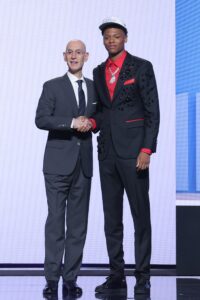 So, despite entering the offseason with one of the NBA’s most favorable salary cap situations, the Jazz essentially sat out of free agency. They completed three Exhibit 10 signings, including one with former lottery pick Mo Bamba, but didn’t hand out a single dollar of guaranteed money to a free agent.
So, despite entering the offseason with one of the NBA’s most favorable salary cap situations, the Jazz essentially sat out of free agency. They completed three Exhibit 10 signings, including one with former lottery pick Mo Bamba, but didn’t hand out a single dollar of guaranteed money to a free agent.
And while the Jazz hung onto forward Lauri Markkanen and center Walker Kessler, the two most valuable established building blocks on the roster, they spent the summer purging the roster of most of their other productive veterans.
Jordan Clarkson, who won a Sixth Man of the Year award in 2021 and had averaged 17.5 points per game since being traded to the Jazz in 2019, was bought out of his expiring $14.1MM contract, clearing a path for him to sign a minimum-salary deal with the Knicks.
Collin Sexton, the team’s third-leading scorer in 2024/25 with an average of 18.4 points per game on an efficient .480/.406/.865 shooting line, was traded to Charlotte along with a future “most favorable” second-round pick in exchange for Jusuf Nurkic.
That deal with the Hornets was a surprising one from a value perspective, since Sexton and Nurkic are on nearly identical expiring contracts in ’25/26 and Nurkic’s playing time and production dropped off last season. Given that Sexton was Utah’s most valuable guard in ’24/25, it’s hard to view the trade as anything other than a gambit to open up more playing time for the club’s backcourt prospects. And if the development process for those younger guards is up and down, resulting in fewer Jazz wins in the short term, that’s probably just fine with the front office.
The Jazz also sent John Collins to the Clippers in a three-team trade that netted them Kyle Anderson, Kevin Love, a second-round pick, and cash.
It was a relatively modest return for Collins, who put up 19.0 points and 8.2 rebounds per game on .527/.399/.848 shooting last season, since his $26.6MM salary made him a little tricky to move. But at least in this case, Utah created significant cap savings (Anderson and Love combine to earn just $13.4MM) and acquired a future second-rounder instead of giving one up. It also wouldn’t be shocking if the Jazz are able to flip Anderson for positive value at the trade deadline, though Love will likely just be waived or bought out at some point.
Utah’s one trade for a veteran involved forward Georges Niang, a sharpshooter who played some of the best basketball of his career in Atlanta during the second half of last season. The Jazz acquired him from Boston, though that deal was more about the two second-round picks attached to Niang than the player himself — like Anderson, he’s a candidate to be flipped before February’s deadline if Utah can get a decent return.
While vets like Nurkic, Anderson, Love, and Niang are unlikely to have long-term stays in Utah, the Jazz did add a pair of players on draft night that they hope will remain in the organization for years to come. The team used the fifth overall pick to draft Rutgers forward Ace Bailey, then traded up to No. 18 to nab Florida guard Walter Clayton.
The front office deserves kudos for rolling the dice on Bailey, whose camp was reportedly pushing hard for him to end up elsewhere (Washington was believed to be his preferred destination). While there was some brief post-draft speculation about whether or not Bailey would report to Utah, the NBA’s Collective Bargaining Agreement doesn’t give rookies much leverage to hold out, so it came as little surprise when the No. 5 pick confirmed he’d be joining the Jazz and said all the right things about his new home.
Bailey has more upside than any player in the 2025 draft class not named Cooper Flagg or Dylan Harper, and you could even find several talent evaluators around the NBA who were higher on Bailey entering draft night than at least one of those two top picks. He’s not a sure thing to become an All-Star, but he’s exactly the sort of high-ceiling player the Jazz should be taking a shot on after not identifying an obvious star in either of the last two drafts.
As for Clayton, his ceiling isn’t as high as Bailey’s, but he was the leader of a Florida team that won a national title in 2025 and will bring some championship experience to a team that won just 17 regular season games a year ago.
At age 22, Clayton is older than incumbent Jazz guards Keyonte George and Isaiah Collier and figures to push those players for backcourt minutes this fall. It wouldn’t be a shock if he usurped either of them on the depth chart this season, especially after the Jazz gave up three future second-round picks to move up three spots to draft him — Clayton was clearly a prospect the front office specifically targeted.
Up next
While a buyout of Love has long been expected, it doesn’t seem as if he has his next destination lined up yet, so he likely won’t give up any money until that’s sorted out. A roster spot may not open up for him elsewhere until later in the season — the two teams in his hometown of Los Angeles, for instance, won’t be able to add a 15th man until January based on their current hard-cap situations.
The Jazz could simply waive Love at some point before then, since it’s not like they desperately need to save the couple million dollars he might give up. But there’s probably no urgency to make that move unless Bamba has a great camp and the club needs to open up a roster spot to carry him on the regular season squad. If Bamba and the other camp invitees don’t make the team, Utah can simply retain its current 15 players on guaranteed contracts, including Love.
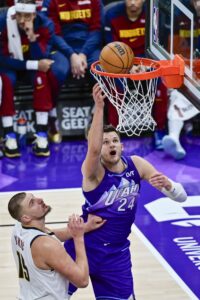 Although Bamba isn’t eligible for a two-way contract, the other two Exhibit 10 signees – Matthew Murrell and Steven Crowl – would qualify, so if they impress in the next week or two, it’s possible the Jazz will make a change to its two-way slots. While Oscar Tshiebwe and John Tonje signed this offseason, Elijah Harkless is a holdover from last season, which could put his roster spot more at risk.
Although Bamba isn’t eligible for a two-way contract, the other two Exhibit 10 signees – Matthew Murrell and Steven Crowl – would qualify, so if they impress in the next week or two, it’s possible the Jazz will make a change to its two-way slots. While Oscar Tshiebwe and John Tonje signed this offseason, Elijah Harkless is a holdover from last season, which could put his roster spot more at risk.
Finally, Kessler looks like the only legitimate extension candidate in Utah this offseason, but a recent report indicated that the two sides aren’t expected to agree to terms before the season begins.
It sounds like the Jazz would be open to getting something done, but only if the terms are very team-friendly. Otherwise, the club would prefer to head into next offseason with Kessler’s relatively modest $14.9MM cap hold in place of what would likely be a bigger first-year salary on a new extension. That will allow the Jazz to maximize their cap room.
For his part, Kessler acknowledged on media day that the situation is somewhat frustrating. It’s worth noting that the young center has been the subject of trade speculation for the better part of the past two seasons. Utah has set a high asking price that teams have thus far been unwilling to meet, but if the 24-year-old is upset at all by how his contract situation is playing out, could the front office become more open to making a deal before February’s deadline? I’m not sure that’s likely, but it’s still worth keeping an eye on in the coming weeks and months.
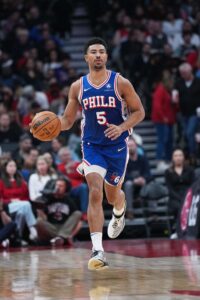
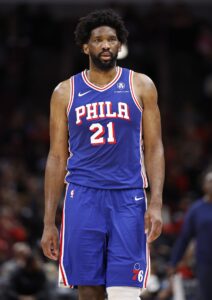 Coming off a massively disappointing year in which the Sixers entered the season as one of the NBA’s title favorites and finished with a 24-58 record, there was some speculation entering the 2025 offseason that the team might look to shake up its roster. President of basketball operations Daryl Morey has never been shy about taking big swings on the trade market, and stars
Coming off a massively disappointing year in which the Sixers entered the season as one of the NBA’s title favorites and finished with a 24-58 record, there was some speculation entering the 2025 offseason that the team might look to shake up its roster. President of basketball operations Daryl Morey has never been shy about taking big swings on the trade market, and stars 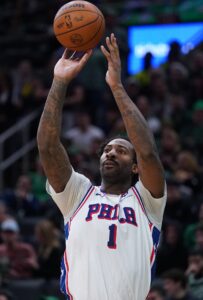 The Sixers are carrying just 14 players on standard contracts, but as we established above, they’re wary of going too much deeper into tax territory, so they’ll likely leave that 15th spot open to start the regular season.
The Sixers are carrying just 14 players on standard contracts, but as we established above, they’re wary of going too much deeper into tax territory, so they’ll likely leave that 15th spot open to start the regular season.
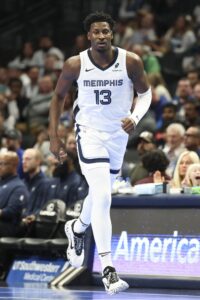 Let’s start with what, in some ways, was the most important decision of the Grizzlies’ offseason — with former Defensive Player of the Year
Let’s start with what, in some ways, was the most important decision of the Grizzlies’ offseason — with former Defensive Player of the Year 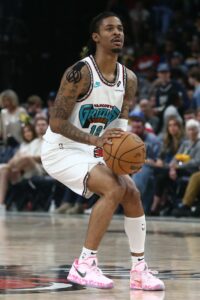 The Grizzlies have 15 players on guaranteed salaries and three on two-way deals, so their regular season roster looks pretty much set. Two-way moves are always a possibility during the preseason, but
The Grizzlies have 15 players on guaranteed salaries and three on two-way deals, so their regular season roster looks pretty much set. Two-way moves are always a possibility during the preseason, but 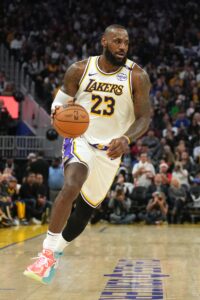 James will turn 41 before the calendar year is over, but he’s not the only NBA player in his 40s like he was a year ago. His good friend
James will turn 41 before the calendar year is over, but he’s not the only NBA player in his 40s like he was a year ago. His good friend 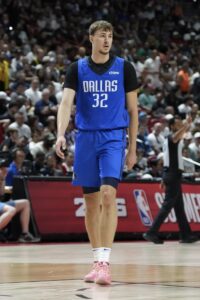
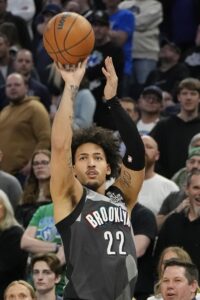 While teams have until Oct. 20 to set their regular season rosters, many clubs will make their final cuts on or before Saturday, October 18. That’s the final day that a team can waive a player on a non-guaranteed contract and avoid paying any of his salary.
While teams have until Oct. 20 to set their regular season rosters, many clubs will make their final cuts on or before Saturday, October 18. That’s the final day that a team can waive a player on a non-guaranteed contract and avoid paying any of his salary.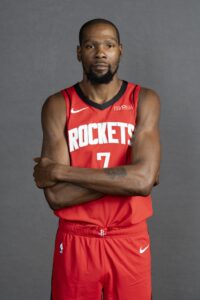 For instance, Rockets forward
For instance, Rockets forward 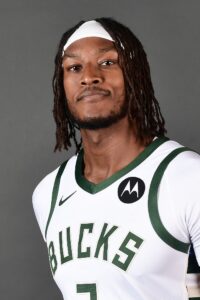
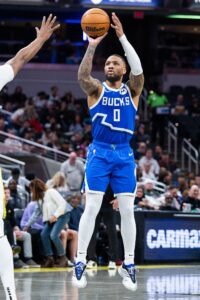 But the Bucks’ front office had plenty of reason to be bold this summer. The team had just been eliminated in the first round of the playoffs for a third straight year, and star point guard
But the Bucks’ front office had plenty of reason to be bold this summer. The team had just been eliminated in the first round of the playoffs for a third straight year, and star point guard 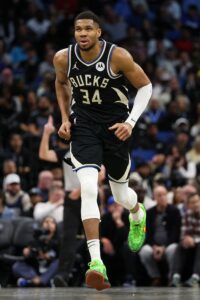 If we were evaluating the roster purely based on projected performance, Thanasis would be a logical release candidate as well, but it’s hard to imagine the Bucks waiving Giannis’ brother while they’re doing all they can to convince him to remain in Milwaukee long-term.
If we were evaluating the roster purely based on projected performance, Thanasis would be a logical release candidate as well, but it’s hard to imagine the Bucks waiving Giannis’ brother while they’re doing all they can to convince him to remain in Milwaukee long-term.
 So, despite entering the offseason with one of the NBA’s most favorable salary cap situations, the Jazz essentially sat out of free agency. They completed three Exhibit 10 signings, including one with former lottery pick
So, despite entering the offseason with one of the NBA’s most favorable salary cap situations, the Jazz essentially sat out of free agency. They completed three Exhibit 10 signings, including one with former lottery pick  Although Bamba isn’t eligible for a two-way contract, the other two Exhibit 10 signees –
Although Bamba isn’t eligible for a two-way contract, the other two Exhibit 10 signees – 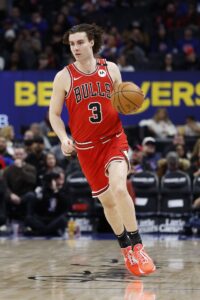
 Instead, the Bulls hung onto all six of those players, and while they did add some multiyear money to their cap in free agency and on the trade market, the primary order of business this summer was keeping the current roster intact by re-signing their own free agents.
Instead, the Bulls hung onto all six of those players, and while they did add some multiyear money to their cap in free agency and on the trade market, the primary order of business this summer was keeping the current roster intact by re-signing their own free agents. Still, I wouldn’t anticipate major changes to the current group during the preseason. The Bulls are more likely to focus on possible extension candidates, with White, Dosunmu, Vucevic, and
Still, I wouldn’t anticipate major changes to the current group during the preseason. The Bulls are more likely to focus on possible extension candidates, with White, Dosunmu, Vucevic, and